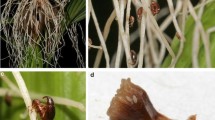Abstract
The role of floral scents in host location by flower-dwelling thrips is investigated by experiment in the field. The scent of anisaldehyde significantly increased the catches of seven species of flower-dwelling thripid, but had no significant effect on three species of cereal thripid and one species of flower-dwelling aeolothripid. The catches of white (without UV) traps were increased by a factor of 3.3 to 8.3 in the presence of the scent.
Similar content being viewed by others
References
Ackerman, J.D. 1983. Specificity and mutual dependence of the orchid-euglossine bee interaction.Biol. J. Linn. Soc. 20:301–314.
Annand, P.N. 1926. Thysanoptera and the pollination of flowers.Am. Nat. 60:177–182.
Appanah, S., andChan, H.T. 1981. Thrips: pollinators of some dipterocarps.Malays. For. 44:234–252.
Attaway, J.A., Pieringer, A.P., andBarabas, L.J. 1966. Origin of citrus flavour components from citrus blossoms.Phytòchemistry 5:1273–1279.
Barnes, M.M., Robinson, D.W., andForbes, A.G. 1954. Attractants for moths of the grape leaf skeletonizer.J. Econ. Entomol. 47:58–63.
Birkinshaw, J.H., Morgan, E.N., andFindlay, W.P.K. 1952. Biochemistry of the wood-rotting fungi. 7. Metabolic products ofPolyporus benzoinus (Wahl.) Fr.Biochem. J. 50:509–517.
Bournier, A., Lacasa, A., andPivot, Y. 1978. Biologie d'un thrips prédateurAeolothrips intermedius (Thysanoptera: Aeolothripidae).Entomophaga 23:403–410.
Brantjes, N.B.M. 1981. Wind as a factor influencing flower-visiting byHadena bicruris (Noctuidae) andDeilephila elpenor (Sphingidae).Ecol. Entomol. 6:361–363.
David, C.T., Kennedy, J.S., Ludlow, A.R., Perry, J.N., andWall, C. 1982. A reappraisal of insect flight towards a distant point source of wind-borne odor.J. Chem. Ecol. 8:1207–1215.
Evans, J. W. 1932. The bionomics and economic importance ofThrips imaginis.Pamph. Coun. Scient. Ind. Res. Aust. 30:1–48.
Faegri, K., andVan Der Pijl, L. 1979. The Principles of Pollination Ecology, 3d ed. Pergamon, Oxford.
Frost, S.W. 1936. Tests on baits for oriental fruit moth.J. Econ. Entomol. 29:757–760.
Gildemeister, E., andHoffmann, Fr. 1928. Die ätherischen Öle, Vol. 1, 3d ed. Schimmel, Miltitz near Leipzig.
Gottsberger, G. 1974. The structure and function of the primitive angiosperm flower—a discussion.Acta Bot. Neerl. 23:461–471.
Gottsberger, G. 1977. Some aspects of beetle pollination in the evolution of flowering plants.Plant Syst. Evol. Suppl. 1:211–226.
Hawkes, C., Patton, S., andCoaker, T.H. 1978. Mechanisms of host plant finding in adult cabbage root fly,Delia brassicae.Entomol. Exp. Appl. 24:419–427.
Holtmann, H. 1963. Untersuchungen zur Biologie der Getreide-Thysanopteren. Teil II.Z. Angew. Entomol. 51:285–299.
Howlett, F.M. 1914. A trap for thrips.J. Econ. Biol. 9:21.
Kirk, W.D.J. 1984a. Ecologically selective coloured traps.Ecol. Entomol. 9:35–41.
Kirk, W.D.J. 1984b. Ecological studies onThrips imaginis Bagnall (Thysanoptera) in flowers ofEchium plantagineum L. in Australia.Aust. J. Ecol. 9:9–18.
Kirk, W.D.J. 1984c. Pollen-feeding in thrips (Insecta: Thysanoptera).J. Zool. 204:107–117.
Kugler, H. 1956. Über die optische Wirkung von Fliegenblumen auf Fliegen.Ber. Dtsch. Bot. Ges. 69:387–398.
Langford, G.S., Muma, M.H., andCory, E.N. 1943. Attractiveness of certain plant constituents to the Japanese beetle.J. Econ. Entomol. 36:248–252.
Lindeman, A., Jounela-Eriksson, P., andLounasmaa, M. 1982. The aroma composition of the flower of meadowsweet (Filipendula ulmaria (L.) Maxim.).Food Sci. Technol. 15:286–289.
Loper, G.M. 1972.Medicago sativa andCitrus depressa flower volatiles.Phytochemistry 11:1865.
Manning, A. 1957. Some evolutionary aspects of the flower constancy of bees.Proc. R. Phys. Soc. Edinburgh 25:67–71.
Morgan, A.C., andCrumb, S.E. 1928. Notes on the chemotropic responses of certain insects.J. Econ. Entomol. 21:913–920.
Mound, L.A., Morison, G.D., Pitkin, B.R., andPalmer, J.M. 1976. Handbooks for the Identification of British Insects. Vol. 1, Part 11. Thysanoptera. Royal Entomological Society, London.
Naves, Y.R.De, andMazuyer, G. 1947. Natural Perfume Materials. Reinhold, New York.
Nilsson, L.A. 1979. The pollination ecology ofHerminium monarchis (Orchidaceae).Bot. Notiser 132:537–549.
Penman, D.R., Osborne, G.O., Worner, S.P., Chapman, R.B., andMcLaren, G.F. 1982. Ethyl nicotinate: a chemical attractant forThrips obscuratus (Thysanoptera: Thripidae) in stonefruit in New Zealand.J. Chem. Ecol. 8:1299–1303.
Perry, A.S., andFay, R.W. 1967. Correlation of chemical constitution and physical properties of fatty acid esters with oviposition response ofAedes aegypti.Mosquito News 27:175–198.
Rodrigues, V. 1980. Olfactory behaviour ofDrosophila melanogaster, pp. 361–371, in O. Siddiqi, P. Babu, L.P. Hall, and J.C. Hall (eds.). Development and Neurobiology ofDrosophila. Plenum Press, New York.
Snapp, O.I., andSwingle, H.S. 1929. Preliminary report on attrahents for peach insects.J. Econ. Entomol. 22:98–101.
Syed, R.A. 1978. Thrips Pollination of Oil Palm in West Malaysia. Commonwealth Institute of Biological Control Report.
Thien, L.B. 1980. Patterns of pollination in the primitive angiosperms.Biotropica 12:1–13.
Uchida, M. 1973. Pesticidal apparatus containing anisaldehyde and cinnamaldehyde. Japanese patent 73-06,537.
Wakayama, S., Namba, S., andOhno, M. 1971. Odorous constituents of lilac flower oil. (In Japanese) (seen in abstract).Nippon Kagaku Zasshi. 92:256–259.
Walker, W.F. 1974. Responses of selected Thysanoptera to colored surfaces.Environ. Entomol. 3:295–304.
Williams, N.H. 1983. Floral fragrances as cues in animal behaviour, pp. 50–72, in C.E. Jones and R.J. Little (eds.). Handbook of Experimental Pollination Biology. Van Nostrand Reinhold, New York.
Author information
Authors and Affiliations
Rights and permissions
About this article
Cite this article
Kirk, W.D.J. Effect of some floral scents on host finding by thrips (Insecta: Thysanoptera). J Chem Ecol 11, 35–43 (1985). https://doi.org/10.1007/BF00987602
Received:
Revised:
Issue Date:
DOI: https://doi.org/10.1007/BF00987602




